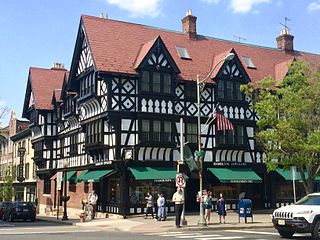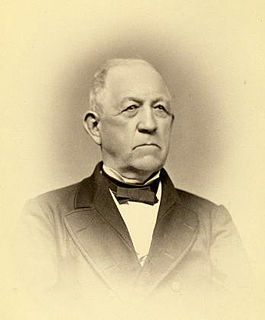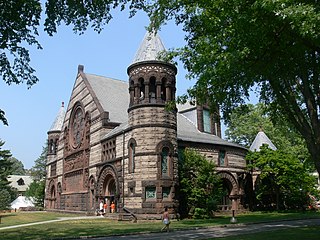
Princeton University is a private Ivy League research university in Princeton, New Jersey. Founded in 1746 in Elizabeth as the College of New Jersey, Princeton is the fourth-oldest institution of higher education in the United States and one of the nine colonial colleges chartered before the American Revolution. The institution moved to Newark in 1747, and then to the current site nine years later. It officially became a university in 1896 and was subsequently renamed Princeton University.

Michael Graves was an American architect, designer, and educator. As well as principal of Michael Graves and Associates and Michael Graves Design Group, he was of a member of The New York Five and the Memphis Group – and professor of architecture at Princeton University for nearly forty years. Following his own partial paralysis in 2003, Graves became an internationally recognized advocate of health care design.

Rutgers University, formally known as Rutgers, The State University of New Jersey, is a public land-grant research university based in New Brunswick, New Jersey. Chartered in 1766, Rutgers was originally called Queen's College. It is the eighth-oldest college in the United States, the second-oldest in New Jersey, and one of the nine U.S. colonial colleges that were chartered before the American War of Independence. In 1825, Queen's College was renamed Rutgers College in honor of Colonel Henry Rutgers, whose substantial gift to the school had stabilized its finances during a period of uncertainty. For most of its existence, Rutgers was a private liberal arts college but it has evolved into a coeducational public research university after being designated The State University of New Jersey by the New Jersey Legislature via laws enacted in 1945 and 1956.

Princeton is a municipality with a borough form of government in Mercer County, New Jersey, United States, that was established in its current form on January 1, 2013, through the consolidation of the now-defunct Borough of Princeton and Princeton Township. Centrally located within the Raritan Valley region, Princeton is a regional commercial hub for the Central New Jersey region and a commuter town in the New York metropolitan area. As of the 2010 United States Census, the municipality's population was 28,572, reflecting the former township's population of 16,265, along with the 12,307 in the former borough.

John Witherspoon was a Scottish American Presbyterian minister, slaveholder, and Founding Father of the United States. Witherspoon embraced the concepts of Scottish common sense realism, and while president of the College of New Jersey became an influential figure in the development of the United States' national character. Politically active, Witherspoon was a delegate from New Jersey to the Second Continental Congress and a signatory to the July 4, 1776, Declaration of Independence. He was the only active clergyman and the only college president to sign the Declaration. Later, he signed the Articles of Confederation and supported ratification of the Constitution. In 1789 he was convening moderator of the First General Assembly of the Presbyterian Church in the United States of America.

The Princeton School of Public and International Affairs is a professional public policy school at Princeton University. The school provides an array of comprehensive coursework in the fields of international development, foreign policy, science and technology, and economics and finance through its undergraduate (AB) degrees, graduate Master of Public Affairs (MPA), Master of Public Policy (MPP), and PhD degrees. Since 2012, Cecilia Rouse has been dean of the Princeton School. The school is consistently ranked as one of the best institutions for the study of international relations and public affairs in the country and in the world. Foreign Policy ranks the Princeton School as No. 2 in the world for International Relations at the undergraduate and No. 4 at the graduate level, behind the Edmund A. Walsh School of Foreign Service at Georgetown University.

Charles Hodge was a Presbyterian theologian and principal of Princeton Theological Seminary between 1851 and 1878.

Joseph Hooton Taylor Jr. is an American astrophysicist and Nobel Prize laureate in Physics for his discovery with Russell Alan Hulse of a "new type of pulsar, a discovery that has opened up new possibilities for the study of gravitation."
Oskar Morgenstern was an economist. In collaboration with mathematician John von Neumann, he founded the mathematical field of game theory and its application to economics.

Princeton Theological Seminary(PTS), officially The Theological Seminary of the Presbyterian Church in the United States of America, is a private school of theology in Princeton, New Jersey. Founded in 1812 under the auspices of Archibald Alexander, the General Assembly of the Presbyterian Church (USA), and the College of New Jersey, it is the second-oldest seminary in the United States. It is also the largest of ten seminaries associated with the Presbyterian Church.

Samuel Lewis Southard was a prominent U.S. statesman of the early 19th century, serving as a U.S. Senator, Secretary of the Navy, and the tenth governor of New Jersey. He also served as President pro tempore of the Senate, and was briefly first in the presidential line of succession.

John Insley Blair was an American entrepreneur, railroad magnate, philanthropist and one of the 19th century's wealthiest men.
Princeton University was founded in Elizabeth, New Jersey, in 1746 as the College of New Jersey, shortly before moving into the newly built Nassau Hall in Princeton. In 1783, for about four months Nassau Hall hosted the United States Congress, and many of the students went on to become leaders of the young republic.

William Appleton Potter was an American architect who designed numerous buildings for Princeton University, as well as municipal offices and churches. He served as a Supervising Architect of the Treasury from 1874 to 1877.

Howard Crosby Warren was an American psychologist and the first chairman of the Princeton University Psychology department. He was also president of the American Psychological Association in 1913.
James Sproat Green was an American lawyer who served as U.S. Attorney for the District of New Jersey from 1835 to 1850. He was the father of New Jersey Governor Robert Stockton Green.

Princeton High School (PHS) is a four-year comprehensive public high school in Princeton, New Jersey, United States, operating as part of the Princeton Public Schools district, which serves all public school students in Princeton. Students from Cranbury Township attend PHS as part of a sending/receiving relationship with the Cranbury School District. The school has been accredited by the Middle States Association of Colleges and Schools Commission on Elementary and Secondary Schools since 1932.

John Cleve Green was a merchant and former partner of John Murray Forbes in the China trading house of Russell & Company. Green was a major benefactor of Princeton University and the Lawrenceville School, giving upwards of 1.5 million dollars, perhaps 2 million, to Princeton. On his death he also made major bequests to New York University and New York area hospitals.
Princeton University School of Engineering and Applied Science is located in Princeton, New Jersey, United States. A school within Princeton University, which is one of the eight universities of the Ivy League, it provides undergraduate and graduate instruction in six departments: chemical and biological engineering, civil and environmental engineering, computer science, electrical engineering, mechanical and aerospace engineering, and operations research and financial engineering. It has more than 1,400 undergraduates, 620 graduate students and 147 faculty members in its six departments.

Saint Joseph's Seminary was an American Roman Catholic educational institution located in Plainsboro, New Jersey, though with an address in Princeton, New Jersey. It was founded in 1914 and was operated by the Congregation of the Mission, better known as the Vincentian Fathers, for the formation of their members and other candidates to the Catholic priesthood. The school closed in 1992 and a retreat center occupied the site until 2009. The Mother of God Orthodox Church had also occupied a small portion of the seminary until 2015 when American Boychoir School had been relocated there. The site is now home to private schools, but the Chapel of the Miraculous Medal is now home to the Princeton Abbey and Cemetery. The Abbey is now a public cemetery and event space for the Princeton area.



















